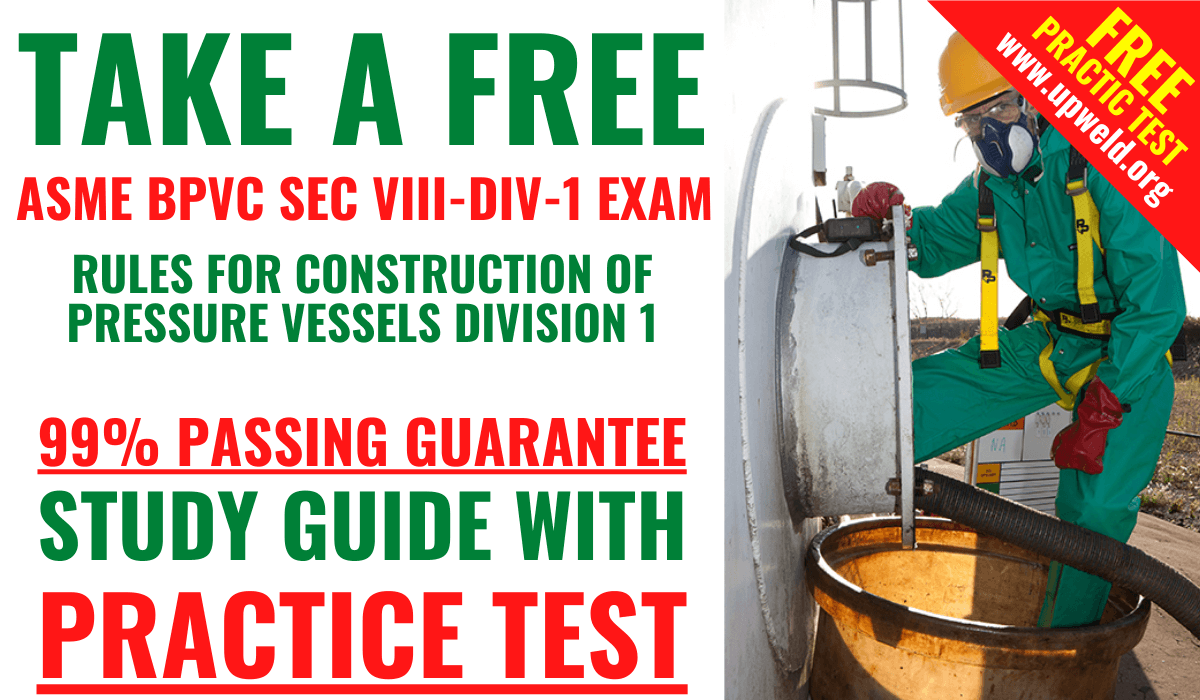Here you can take the Free ASME BPVC Sec VIII–Div-1 Exam Practice Test with the Latest BPVC Section VIII-Rules for Construction of Pressure Vessels Division 1 Questions and Answers
Are You Looking for a Free ASME BPVC Section VIII–Division 1 Exam Practice Test?

If your answer is yes then you are at the right website. Here You Can Take a Free Online ASME BPVC Section VIII–Division 1 Exam Practice Test and Improve Your ABPVC Section VIII-Rules for Construction of Pressure Vessels Division 1 Exam Score. Here You Can Learn everything you need to know about ASME BPVC SEC VIII-DIV-1 quickly and easily.
In This Practice test, We are covering Latest ASME BPVC Section VIII-Rules for Construction of Pressure Vessels Division 1 Question with Answers, After completing the last Question you will see the ASME BPVC Section VIII–Division 1 Practice Test Answer Key, No cheating now! Once you complete the test and check your answers please leave us your score and any comments in the comments section below
We will help you to pass the ASME BPVC Section VIII–Division 1 Exam on the first attempt —99% Guaranteed. Our expert-written ASME BPVC Section VIII-Rules for Construction of Pressure Vessels Division 1 Examination practice material covers the actual exam topics with fully explained answers.
Take unlimited free ASME BPVC Section VIII–Division 1 Quiz Course tests of any length. We have free Latest questions updated every week and you can study our material along with any other study materials.
In This Practice Test We are covering all the topics:
- Pressure vessel design, fabrication, and pre-com:
- Joint Efficiency
- Static Pressure Head
- Internal and External Pressure
- Pressure testing (Pre-Com)
- Exemption from Impact Testing (CVN-Charpy-Notch)
- Opening Attachment Weld Sizing
- Nozzle Reinforcement
Top 68 Latest ASME B 31.3 Exam Questions and Answers
If You Want to Buy the Latest ASME BPVC Section VIII–Division 1 Exam Self Study Material, Please Feel Free to contact us
Buy ASME B31.1 Exam Learning Package Study Material
FOR EVERY 10 QUESTIONS 1 QUESTION COMES INTO THE EXAM
WE HAVE LATEST ASME BPVC Sec VIII-Rules for Construction of Pressure Vessels Div 1 Exam QUESTION BANK
Total 1000+ nos QUESTION BANK FROM THEORY TO PRACTICAL TO NUMERICALS.
Cost: $25.00
Email Us To Buy: upweld.org@gmail.com
Click Here To Contact us On Whatsapp https://wa.link/4dn6ee
Ideally, the only material needed for passing the examination. Free guidelines during learning.
We give you a lot of additional study material Free of cost with this question bank.
Get BOTH Formats Instantly:
Online—Instant scoring, review & reporting.
Printable—Instant download.
If you want to get ASME BPVC Section VIII-Rules for Construction of Pressure Vessels Division 1 Training and Certification, Please feel free to contact us.
Click Here to Take a Free Practice Test of the API 510 Exam with the Latest Questions and Answers
Click Here to Take a Free Practice Test of the API 570 Exam with the Latest Questions and Answers
Click Here to Take a Free Practice Test of the API 653 Exam with the Latest Questions and Answers